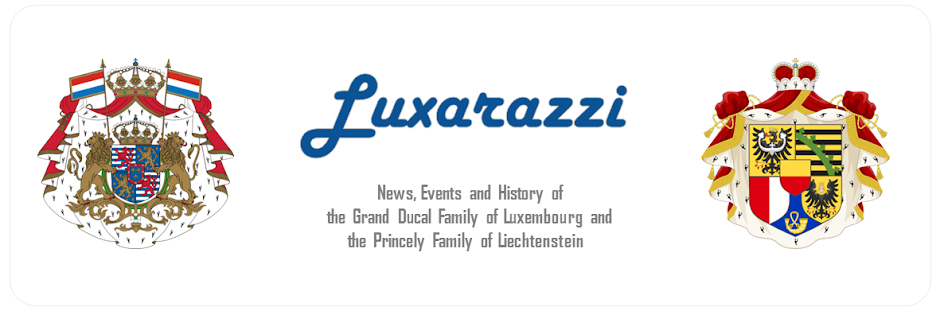 |
| Photo: LCTO |
Every year during the Luxembourgish summer holidays the cour opens its doors and interested visitors are able to visit the Palais grand-ducal in Luxembourg-City. This year, Luxarazzi was one of them. The guided tour lasts between 30 and 45 minutes and is available in Luxembourgish, French, German, Dutch and English. The entrance fee for adults is seven euros, children pay half of it. All proceeds go to the Fondation du Grand-Duc et de la Grand-Duchesse.
Unfortunately, you are not allowed to take pictures
during the tour, nor is there a catalogue with further details and/or
pictures available. The only written information you can get is a flyer in
French, German and English published by the Luxembourg City Tourist Office (LCTO).
The Palais grand-ducal is used as the official
residence of the monarch since 1815, when the new King of the Netherlands was also
made Grand Duke of Luxembourg.
If you visit the palace today you can see a lot of
memorabilia of Luxembourg’s moving past in it. Not only do all reigning Grand Dukes and Duchesses as well as their spouses from Adolph and Marie-Adelheid onwards look at you, but also the
rich interior with hundreds of furniture, chandeliers, paintings, carpets and
china represent the history of the family and the country quite remarkably.
The tour starts at the back of the palace in the Rue du Rost. This is a side entrance normally used by the Grand Ducal
staff and suppliers. The Grand Ducal family, the members of the Chamber of
Deputies and official guests always enter the palace from main entrance on the
opposite side of the palace (the one always seen on tv and pictures).
 |
| Photo: LCTO |
The first saloon you
see inside the building is the so called “Salle de la Balance” (“The Balance
saloon”). Originally “The Balance” was an independent building on the right
side of the palace which was erected between 1741 and 1743. When the palace was
enlarged between 1891 and 1894, it was included into the new building complex.
After that you cross the artrium
and enter the entrance hall of the palace with its famous “Escaliers
d’honneur” (“stairs of honour”). Traditionally, the first photo-call and
introduction of the fiancée of the Hereditary Grand Duke takes place here. Next
you see the “Salle d’armes” which is used as an official living and
meeting room (and not very cosy in my opinion ;-)).
 The tour continues upstairs. It’s quite an
impressive feeling when you walk up the “Escaliers d’honneur” and enter the
“Hall d’honneur” (“Hall of honour”). From here you can enter all official rooms
on the first floor in a direct way. Opposite the stairs, there is the “Salle des fêtes”
(“Celebration Hall”), a large room where smaller occasions take place. The next
two rooms are the “Salon rose” (“Red saloon”) and the “Salon des Rois” (“King's
saloon”). As the names already suggest, the first one is red while the second
one has, in the past, only been used by the monarch to welcome foreign sovereigns. The
second to last room is the “Galerie des gravures” (“Engraving gallery”) in
which you see plenty of engravings, paintings and other objects of art. These
pieces are part of the Grand Ducal collection. The last room of the tour is the
“Salle à manger” (“Dining room”) in which official dinners take place.
The tour continues upstairs. It’s quite an
impressive feeling when you walk up the “Escaliers d’honneur” and enter the
“Hall d’honneur” (“Hall of honour”). From here you can enter all official rooms
on the first floor in a direct way. Opposite the stairs, there is the “Salle des fêtes”
(“Celebration Hall”), a large room where smaller occasions take place. The next
two rooms are the “Salon rose” (“Red saloon”) and the “Salon des Rois” (“King's
saloon”). As the names already suggest, the first one is red while the second
one has, in the past, only been used by the monarch to welcome foreign sovereigns. The
second to last room is the “Galerie des gravures” (“Engraving gallery”) in
which you see plenty of engravings, paintings and other objects of art. These
pieces are part of the Grand Ducal collection. The last room of the tour is the
“Salle à manger” (“Dining room”) in which official dinners take place. This year a special bonus was given to the visitors as the Hereditary Grand-Duchess' wedding dress is exhibited during the tour. I was pretty excited to see it because I thought that Stephanie looked stunning on her wedding day. To be honest I was quite disappointed when I saw it in real life. The dress didn't look as beautiful and shiny on the dummy as it looked on Hereditary Grand-Duchess Stephanie.
The Luxembourgish parliament, the Chamber of Deputies, which has been situated right next to the palace since 1858/59, can’t be visited during the tour. You also cannot visit the left wing of the palace which is the oldest still existing part of the original town hall built in 1418. It was rebuilt in 1573 after a gunpowder explosion in 1554.
All in all the palais is worth visiting. Not only for people who are interested in the Grand Ducal family or Luxembourg but also for people who are generally interested in arts, architecture and history.
For more information about the palais in general and its history, check out our Luxarazzi 101 post about it.

No comments:
Post a Comment